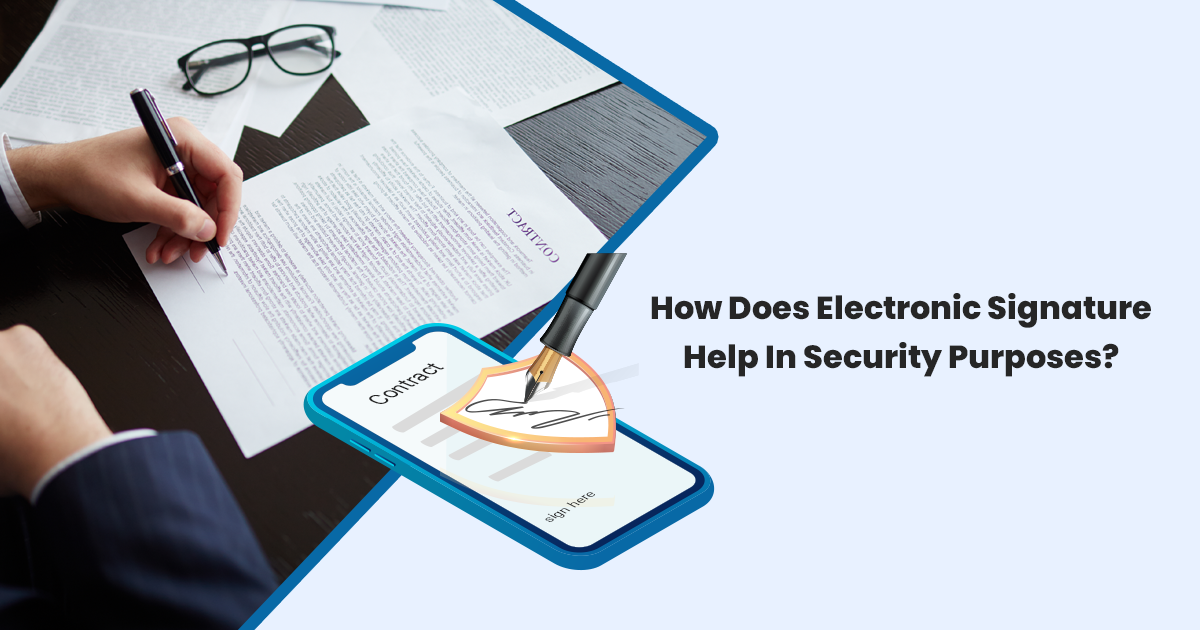An electronic signature is a mathematical method that is used to validate the integrity and authenticity of a message, electronic document, and software. It is fundamentally a digital equivalent of a signature or a stamped seal because it provides greater security and compliance.
The use of electronic signatures is intended to solve grave problems of fraud, impersonation, and tampering that happen in digital communication.
The use of electronic signatures can offer evidence of origin, the status of esign documents, identity, digital messages, and transactions.
The signers can in fact create online signatures for acknowledging the informed consent.
Electronic signatures are legally binding in the manner of traditional handwritten document signatures. They are mostly used for industrial and regional purposes because of the excellent security that they offer.
Applications of Electronic Signature
Some of the most important reasons to use or implement the electronic signatures for helping communication are:
Authentication
A process that verifies the identity of a user who wishes to access the system is called authentication. While using the electronic signature software, authentication enables the authentication of the sources of messages.
Integrity
The integrity of documents ensures that the message is always accurate, real and protects the unauthorized user modification at the time of transmission.
Non-Repudiation
Non-repudiation signifies assurance of something that is not denied. It helps in ensuring that someone can communicate or an official contract that cannot be denied later. The authenticity of an electronic signature to a word document or in a file or sending the message that gets originated.
Role of Electronic Signatures
In multiple regions across the world including prominent parts of the European Union, North America, and APAD, electronic signatures are known as legally binding. They hold the same value as the traditional document signatures.
Other than digital document signing, they are also utilized for financial transactions, software distribution, email service providers, digital communications, and areas that ensure authenticity to be crucial.
The industry-standard technology called the Public key infrastructure makes sure that an electronic signature ensures data integrity and authenticity.
Electronic Signature Increase Security
The advancing technology responsible for electronic signatures is termed the Public Key Infrastructure. For the industries to go entirely paperless, the reliance is on securing signatures for the legal documents.
Hence, a safe and secure way is necessary for protecting electronic signatures for the users and businesses.
The Public Key Infrastructure utilizes asymmetric key pair encryption to make this happen. One of the best ways to decrypt the important data with a key in a pair is by using another significant key in the pair.
This pair is composed of a public key and an entirely private key. The public key might as well be shared freely because it does not need to stay confidential.
On the other hand, the private key should be kept a secret. The owner of the key pair should also protect the private key very closely because non-repudiation and sender authenticity is dependent on the signer with sole access to the private key.
An authority that confirms and verifies the identity of a person before issuing a certificate certifies the key pair. This also forms the Digital identity for an individual and the certificate so issued is known as a Digital Certificate.
It must be noted that there are some important characteristics of these key pairs. These characteristics are mathematically linked to one another and it is impossible to calculate one key from the other. Hence, the private keys can never be compromised with the knowledge that is usually associated with the public key.
In addition, every key in the key pair performs the inverse function of the other. What one of these keys might do is undone by another. The private key is well utilized for signing and decrypting an important message or a document while the public key is utilized for verifying or encrypting.
There are some important steps taken in this process. They are mentioned below:
- An individual is responsible for applying to the Certification Authority for getting the Digital Certificate.
- The CA proofs are responsible for identifying the individual and issuing the Digital Certificate.
- It is on the CA to publish the certificate repository.
- An individual is supposed to digitally sign the electronic message with a Private Key for ensuring the sender’s authenticity, non-repudiation, and message integrity and sending the message.
- The receiving party gets the message, verifies the electronic signature with the individual Public Key, and goes to the repository for checking the validity and status of an individual’s certificate.
- The repository returns the results of the status check on the individual’s certificate for verifying the party.
There is an increasing need for improved cybersecurity when it comes to electronic signatures. With higher education, one of the most important areas in electronic signature technology reduces the risk of viruses, attacks, and spam that are faced by organizations at a mass level.
In addition to protecting the information on the internet, it also plays an important role in reducing the use of paper.
With the help of PKI technology, the electronic signature provides a unique and much-needed safe solution to real problems.
Creating electronic Signature
There are some steps followed to create an online signature. They are:
- Choose a file that is signed digitally.
- After this, the hash value of a message or the content of the file gets calculated. Then, it gets encrypted with the use of a private key of a sender to form an electronic signature.
- The original message or content of a file in addition to the electronic signature gets transmitted.
- The electronic signature is then decrypted with the use of a public key of a sender.
- This helps the receiver get the message or file content to compute it further.
- Comparison of computed messages or the content of a file with the original computed message. This comparison is similar to ensuring integrity.
Conclusion
Just as what they sound like, electronic signature software serves as an excellent alternative to signing documents with paper and a pen. These signatures use a mathematical technique for checking the integrity and authenticity of digital messages and documents.
If you want to ensure security and compliance then electronic signatures are the best possible alternative.




